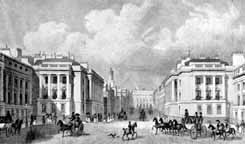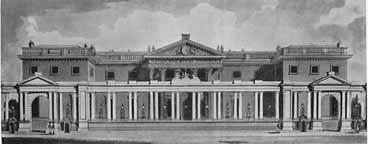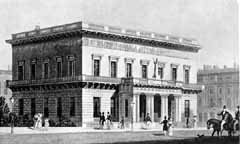[Added by George P. Landow, Dean, University Scholars Programme, National University of Singapore; Professor of English and Art History, Brown University]

he Clubs had their origin in the old Coffee Houses which came into existence as a result of the introduction of coffee into England from Turkey, by David Saunders, in the year 1652. So rapid was the success of the new beverage, so universally was it found to lend itself to social gatherings, to promote conversation, and alas to afford opportunities for gambling, that by the middle of Queen Anne's reign the number of Coffee Houses in London and Westminster had grown to several hundreds, some imaginative estimates putting the figure at 2,000.
Mr. Spectator dealt with the Coffee House in several numbers, all conveying the true impression that the Coffee Houses were an important, nay, an essential feature in the London life at that time. Moreover, it is clear that people frequented them, not so much for the Coffee as for the Conversation. Serious conversation generally; that is to say, conversation either about business or about public affairs. "It is very natural," writes Steele, "for a man who is not tuned for Mirthful Meetings of Men, or Assemblies of the fair Sex, to delight in that sort of conversation which we find in Coffee Houses." There he can talk, or if he cannot talk, he can listen, while Mr. Beaver the Haberdasher "has the Audience and Attention of his Neighbours from Six in the morning till a Quarter of Eight," declaring " what measures the Allies must enter into upon this new Posture of Affairs." . . . Unfortunately neither Mr. Beaver, nor the noted men of business, nor the politicians of St. James's, nor the literary men at Will's, had the monopoly of the Coffee Houses. There were "Enormities" also, as Steele calls them; frivolous disputants, wagerers, whisperers, intruders of all sorts, who in time began to make fastidious persons ask for a new kind of accommodation.
The Athenaeum, 1830. [Click on picture for larger image and additional information.]
Hence arose the clubs in our modern sense; houses for the chosen few, where men of common tastes and of one class might meet together. In the fashionable neighbourhoods the indiscriminate type of Coffee Houses almost disappeared, giving place to houses which . . . adopted a political or party colour of their own. Thus, before the middle of the century we read of the Whigs gathering at the St. James's Coffee House in the street of that name, the Tories assembling at Ozinda's, close to the Palace, and the jacobites at the Cocoa Tree in Pall Mall and St. James's Street. . . Much earlier, as every student knows, "Will's" in Bow Street had been frequented by Dryden, and "Button's" in Russell Street by Addison. The most famous of all bore a name which still survives; it was "White's Chocolate House" — in St. James's Street, which was founded in 1693 by Francis White on a site much farther down the street than that occupied by the present building. . . . It was at first "open to all decent folk" and "class distinctions were waived in conversation," but soon the men of fashion who frequented it in considerable numbers proposed and carried out a change, and it was made into a Club very much after the modern type. . . . Later the Club was removed to the present well-known building at the top of the street, where it has preserved to the present day its exclusive social character, and to a certain extent its Tory-tinge. Not so decisively, however, as was the case, in the interest of the Whigs, of its Whig rival across the way, still named after its founder Brooks, the wine merchant and money lender . . . Brooks indeed was not the real founder, but the more celebrated Almack, who had set up the establishment in Pall Mall simply as a gaming-house. In 1764, Almack moved to King Street, where he built rooms named after his son-in-law Willis; rooms which still bear the name, though they were shattered by a bomb during the Great War and subsequently rebuilt. Brooks took over the house in St. James's Street, where it became definitely the Whig Club, its leading members being the Dukes of Portland and Richmond and Mr. Crewe. The Club was moved to its present site in 1778, and the house was built by one of the most prolific architects of the day, Henry Holland.


Left: Waterloo Place, 1830. Right: John Wilson Croker.
[Click on pictures for larger images and additional information.]
Club life [developed rapidly] . . . during and after the Napoleonic Wars. . . . [John Wilson Croker, founder of the Athenaeum, complained in 1823] that "the fashionable and military clubs have not only absorbed a great portion of society, but have spoiled all the coffee houses and taverns," and he claims . . . that there was a pressing need for such a club as soon after took shape in the Athenaeum. Besides the clubs in St. James's Street, to which we have referred, there were, when Croker wrote, at least three new clubs covering new ground — the United Service, the Travellers', and the Union, while the Universities were about to provide two important buildings for their graduates, many of whom were living in London. . The United Service was founded in 1815 "for officers of not less rank than Major in the Army and Captain in the Navy." The Union Club, designed for merchants, lawyers, Members of Parliament and "gentlemen at large," was built in Trafalgar Square in 1822 by Sir Robert Smirke; . . . The Travellers' is slightly older; it dates from the Peace of 1814, when Castlereagh suggested the need of such a house " for the resort of gentlemen who have resided or travelled abroad " and for foreigners visiting London. The immense development of club life which was to take place during the next ten years and which was entirely to transform Pall Mall, dates from the destruction of the Royal Palace, called Carlton House. . . .

Carlton House. Click on picture for larger image and additional information.
The number of literary men, artists, and men of science to be found in London had greatly increased, and doubtless to many of these excellent people there had occurred the question, why should we not have the same opportunities for association and common action as those already possessed by the aristocracy, the Services, and the politicians? Such, at least, was the question that suggested itself to the acute and practical mind of John Wilson Croker, Member of Parliament and Secretary to the Admiralty, and the question was not set at rest until he had founded the Athenaeum. [Ward, pp. 3-8]
Related material
Bibliography
Ward, Humphry. History of the Athenaeum, 1824-1925. London: Printed for the Club, 1926.
Last modified 14 December 2015
